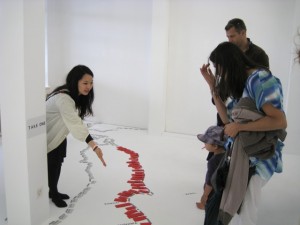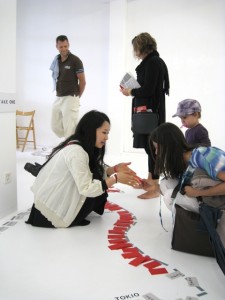 You see a huge map of Japan and red envelopes when you enter the gallery. This is Ingo’s latest work, “Thanks a Million.” He was preparing the work at the Miraikan in Odaiba when the 311 earthquake happened. He was also interested in the beauty of the Japanese coastline which was expressed as “White sand and blue pine tree”. His aim is to restore the Japanese coastline. He made a Japanese map by cards which says “White sand and blue tree.” In the red envelopes, there was a thank-you card written in red and black letters. When you took the card out of the envelope you could see the red letters—which you could not when the card was inside—spelling out a detailed message. This is the set-up to give an audience a detailed message. In the red envelope there are pine-tree seeds; members of the audience who took the envelopes would plant the seeds in their garden. This artwork makes the link between Japan and people who visited the exhibition. In the card you find the message: “Please do not forget about Japan that needs long-term support and view the reconstruction of Japan with us. Thanks a million.”
You see a huge map of Japan and red envelopes when you enter the gallery. This is Ingo’s latest work, “Thanks a Million.” He was preparing the work at the Miraikan in Odaiba when the 311 earthquake happened. He was also interested in the beauty of the Japanese coastline which was expressed as “White sand and blue pine tree”. His aim is to restore the Japanese coastline. He made a Japanese map by cards which says “White sand and blue tree.” In the red envelopes, there was a thank-you card written in red and black letters. When you took the card out of the envelope you could see the red letters—which you could not when the card was inside—spelling out a detailed message. This is the set-up to give an audience a detailed message. In the red envelope there are pine-tree seeds; members of the audience who took the envelopes would plant the seeds in their garden. This artwork makes the link between Japan and people who visited the exhibition. In the card you find the message: “Please do not forget about Japan that needs long-term support and view the reconstruction of Japan with us. Thanks a million.”
Gunther’s work is related to the only tree left after the devastation caused by the tsunami in Rikuzentakata city. It also has some connection with the work screened on the underground floor of this exhibition, Joseph Beuys’s “7000 Oaks” project (1982).
 Many people understand the situation in Japan and have responded with red envelopes and words like FUKUSIMA, SENDAI, TOKIO, and have left comments such as “It is a good idea,” “I will plant it in our backyard,” or “Thank you,” expressing their sympathy for Japan. One woman came up to tell us: “I will look after this pine tree for Japan as well as I would my child.” We felt we could show the possibility of supporting people in the Tohoku area through Art.
Many people understand the situation in Japan and have responded with red envelopes and words like FUKUSIMA, SENDAI, TOKIO, and have left comments such as “It is a good idea,” “I will plant it in our backyard,” or “Thank you,” expressing their sympathy for Japan. One woman came up to tell us: “I will look after this pine tree for Japan as well as I would my child.” We felt we could show the possibility of supporting people in the Tohoku area through Art.
(Report: Mika Maruyama)
